Adrian G. Bors
Unsupervised Video Continual Learning via Non-Parametric Deep Embedded Clustering
Aug 29, 2025Abstract:We propose a realistic scenario for the unsupervised video learning where neither task boundaries nor labels are provided when learning a succession of tasks. We also provide a non-parametric learning solution for the under-explored problem of unsupervised video continual learning. Videos represent a complex and rich spatio-temporal media information, widely used in many applications, but which have not been sufficiently explored in unsupervised continual learning. Prior studies have only focused on supervised continual learning, relying on the knowledge of labels and task boundaries, while having labeled data is costly and not practical. To address this gap, we study the unsupervised video continual learning (uVCL). uVCL raises more challenges due to the additional computational and memory requirements of processing videos when compared to images. We introduce a general benchmark experimental protocol for uVCL by considering the learning of unstructured video data categories during each task. We propose to use the Kernel Density Estimation (KDE) of deep embedded video features extracted by unsupervised video transformer networks as a non-parametric probabilistic representation of the data. We introduce a novelty detection criterion for the incoming new task data, dynamically enabling the expansion of memory clusters, aiming to capture new knowledge when learning a succession of tasks. We leverage the use of transfer learning from the previous tasks as an initial state for the knowledge transfer to the current learning task. We found that the proposed methodology substantially enhances the performance of the model when successively learning many tasks. We perform in-depth evaluations on three standard video action recognition datasets, including UCF101, HMDB51, and Something-to-Something V2, without using any labels or class boundaries.
Masked Image Residual Learning for Scaling Deeper Vision Transformers
Sep 25, 2023Abstract:Deeper Vision Transformers (ViTs) are more challenging to train. We expose a degradation problem in deeper layers of ViT when using masked image modeling (MIM) for pre-training. To ease the training of deeper ViTs, we introduce a self-supervised learning framework called \textbf{M}asked \textbf{I}mage \textbf{R}esidual \textbf{L}earning (\textbf{MIRL}), which significantly alleviates the degradation problem, making scaling ViT along depth a promising direction for performance upgrade. We reformulate the pre-training objective for deeper layers of ViT as learning to recover the residual of the masked image. We provide extensive empirical evidence showing that deeper ViTs can be effectively optimized using MIRL and easily gain accuracy from increased depth. With the same level of computational complexity as ViT-Base and ViT-Large, we instantiate 4.5{$\times$} and 2{$\times$} deeper ViTs, dubbed ViT-S-54 and ViT-B-48. The deeper ViT-S-54, costing 3{$\times$} less than ViT-Large, achieves performance on par with ViT-Large. ViT-B-48 achieves 86.2\% top-1 accuracy on ImageNet. On one hand, deeper ViTs pre-trained with MIRL exhibit excellent generalization capabilities on downstream tasks, such as object detection and semantic segmentation. On the other hand, MIRL demonstrates high pre-training efficiency. With less pre-training time, MIRL yields competitive performance compared to other approaches.
Dynamic Appearance: A Video Representation for Action Recognition with Joint Training
Nov 24, 2022
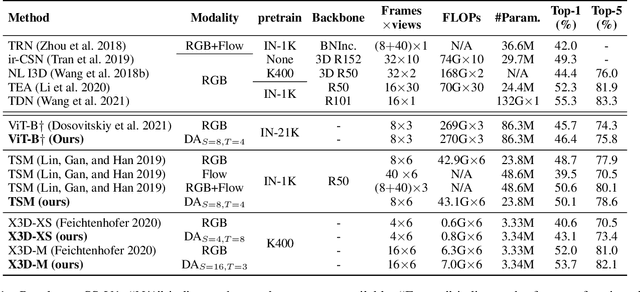
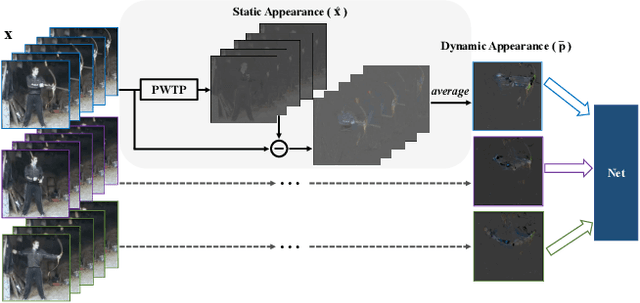
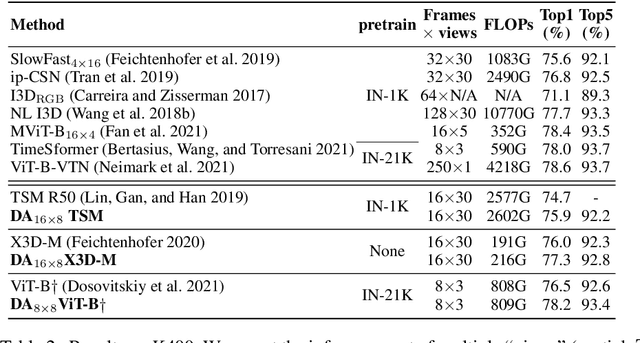
Abstract:Static appearance of video may impede the ability of a deep neural network to learn motion-relevant features in video action recognition. In this paper, we introduce a new concept, Dynamic Appearance (DA), summarizing the appearance information relating to movement in a video while filtering out the static information considered unrelated to motion. We consider distilling the dynamic appearance from raw video data as a means of efficient video understanding. To this end, we propose the Pixel-Wise Temporal Projection (PWTP), which projects the static appearance of a video into a subspace within its original vector space, while the dynamic appearance is encoded in the projection residual describing a special motion pattern. Moreover, we integrate the PWTP module with a CNN or Transformer into an end-to-end training framework, which is optimized by utilizing multi-objective optimization algorithms. We provide extensive experimental results on four action recognition benchmarks: Kinetics400, Something-Something V1, UCF101 and HMDB51.
Task-Free Continual Learning via Online Discrepancy Distance Learning
Oct 12, 2022



Abstract:Learning from non-stationary data streams, also called Task-Free Continual Learning (TFCL) remains challenging due to the absence of explicit task information. Although recently some methods have been proposed for TFCL, they lack theoretical guarantees. Moreover, forgetting analysis during TFCL was not studied theoretically before. This paper develops a new theoretical analysis framework which provides generalization bounds based on the discrepancy distance between the visited samples and the entire information made available for training the model. This analysis gives new insights into the forgetting behaviour in classification tasks. Inspired by this theoretical model, we propose a new approach enabled by the dynamic component expansion mechanism for a mixture model, namely the Online Discrepancy Distance Learning (ODDL). ODDL estimates the discrepancy between the probabilistic representation of the current memory buffer and the already accumulated knowledge and uses it as the expansion signal to ensure a compact network architecture with optimal performance. We then propose a new sample selection approach that selectively stores the most relevant samples into the memory buffer through the discrepancy-based measure, further improving the performance. We perform several TFCL experiments with the proposed methodology, which demonstrate that the proposed approach achieves the state of the art performance.
Continual Variational Autoencoder Learning via Online Cooperative Memorization
Jul 20, 2022



Abstract:Due to their inference, data representation and reconstruction properties, Variational Autoencoders (VAE) have been successfully used in continual learning classification tasks. However, their ability to generate images with specifications corresponding to the classes and databases learned during Continual Learning (CL) is not well understood and catastrophic forgetting remains a significant challenge. In this paper, we firstly analyze the forgetting behaviour of VAEs by developing a new theoretical framework that formulates CL as a dynamic optimal transport problem. This framework proves approximate bounds to the data likelihood without requiring the task information and explains how the prior knowledge is lost during the training process. We then propose a novel memory buffering approach, namely the Online Cooperative Memorization (OCM) framework, which consists of a Short-Term Memory (STM) that continually stores recent samples to provide future information for the model, and a Long-Term Memory (LTM) aiming to preserve a wide diversity of samples. The proposed OCM transfers certain samples from STM to LTM according to the information diversity selection criterion without requiring any supervised signals. The OCM framework is then combined with a dynamic VAE expansion mixture network for further enhancing its performance.
Learning an evolved mixture model for task-free continual learning
Jul 11, 2022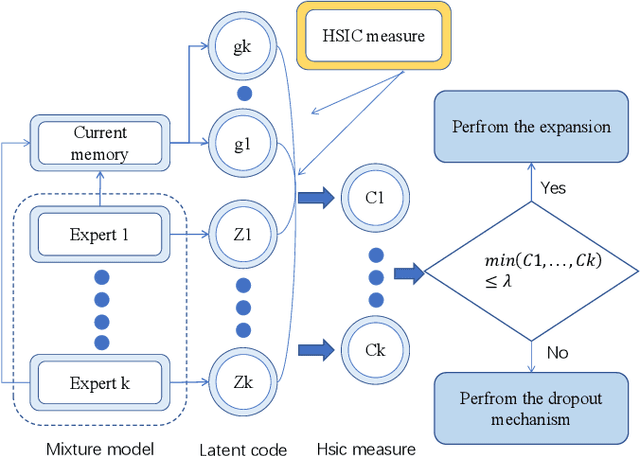
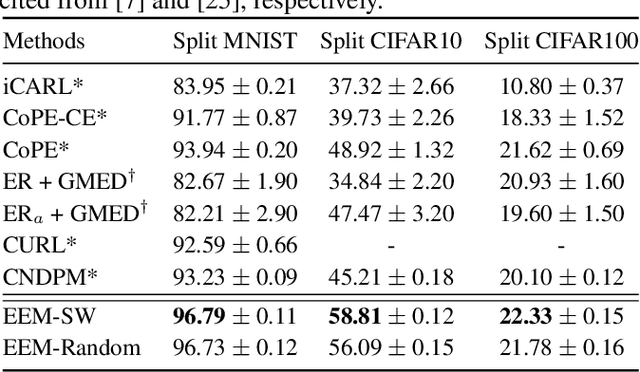
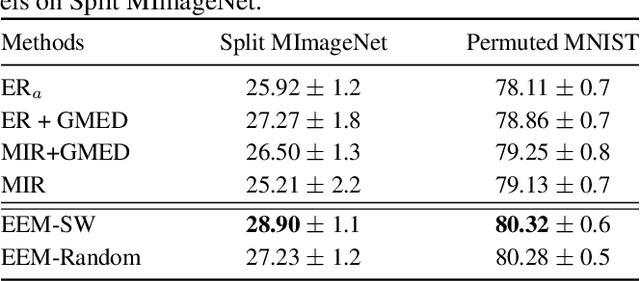
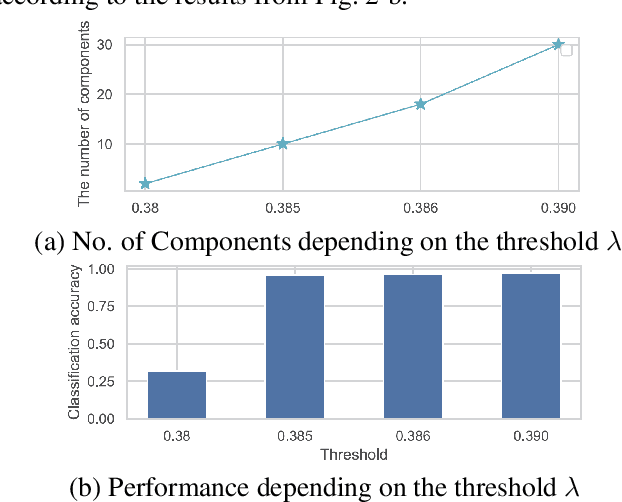
Abstract:Recently, continual learning (CL) has gained significant interest because it enables deep learning models to acquire new knowledge without forgetting previously learnt information. However, most existing works require knowing the task identities and boundaries, which is not realistic in a real context. In this paper, we address a more challenging and realistic setting in CL, namely the Task-Free Continual Learning (TFCL) in which a model is trained on non-stationary data streams with no explicit task information. To address TFCL, we introduce an evolved mixture model whose network architecture is dynamically expanded to adapt to the data distribution shift. We implement this expansion mechanism by evaluating the probability distance between the knowledge stored in each mixture model component and the current memory buffer using the Hilbert Schmidt Independence Criterion (HSIC). We further introduce two simple dropout mechanisms to selectively remove stored examples in order to avoid memory overload while preserving memory diversity. Empirical results demonstrate that the proposed approach achieves excellent performance.
Supplemental Material: Lifelong Generative Modelling Using Dynamic Expansion Graph Model
Mar 25, 2022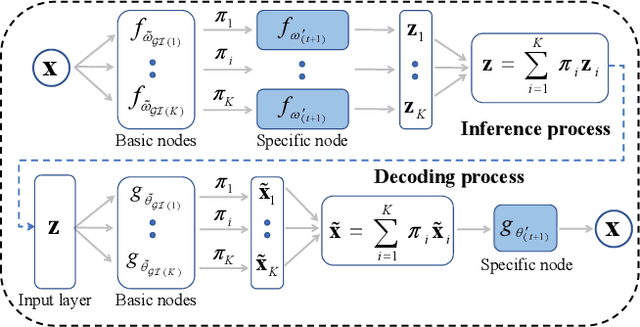
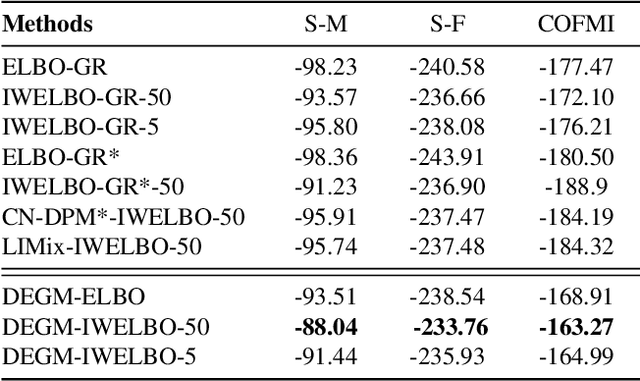
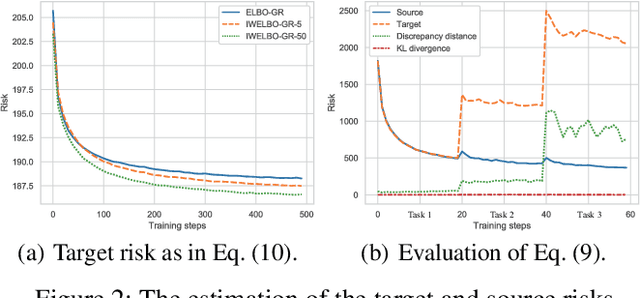

Abstract:In this article, we provide the appendix for Lifelong Generative Modelling Using Dynamic Expansion Graph Model. This appendix includes additional visual results as well as the numerical results on the challenging datasets. In addition, we also provide detailed proofs for the proposed theoretical analysis framework. The source code can be found in https://github.com/dtuzi123/Expansion-Graph-Model.
Lifelong Generative Modelling Using Dynamic Expansion Graph Model
Dec 15, 2021



Abstract:Variational Autoencoders (VAEs) suffer from degenerated performance, when learning several successive tasks. This is caused by catastrophic forgetting. In order to address the knowledge loss, VAEs are using either Generative Replay (GR) mechanisms or Expanding Network Architectures (ENA). In this paper we study the forgetting behaviour of VAEs using a joint GR and ENA methodology, by deriving an upper bound on the negative marginal log-likelihood. This theoretical analysis provides new insights into how VAEs forget the previously learnt knowledge during lifelong learning. The analysis indicates the best performance achieved when considering model mixtures, under the ENA framework, where there are no restrictions on the number of components. However, an ENA-based approach may require an excessive number of parameters. This motivates us to propose a novel Dynamic Expansion Graph Model (DEGM). DEGM expands its architecture, according to the novelty associated with each new databases, when compared to the information already learnt by the network from previous tasks. DEGM training optimizes knowledge structuring, characterizing the joint probabilistic representations corresponding to the past and more recently learned tasks. We demonstrate that DEGM guarantees optimal performance for each task while also minimizing the required number of parameters. Supplementary materials (SM) and source code are available in https://github.com/dtuzi123/Expansion-Graph-Model.
Lifelong Infinite Mixture Model Based on Knowledge-Driven Dirichlet Process
Aug 25, 2021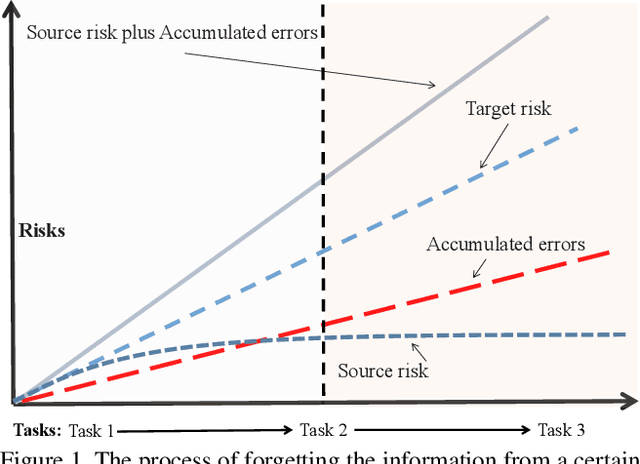

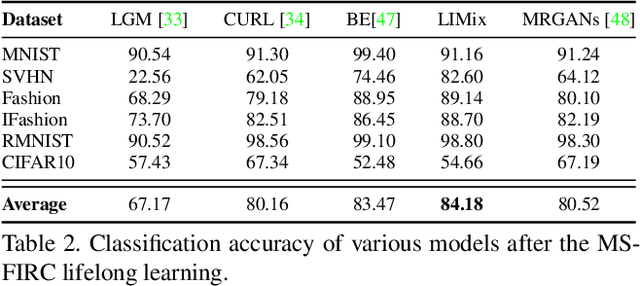

Abstract:Recent research efforts in lifelong learning propose to grow a mixture of models to adapt to an increasing number of tasks. The proposed methodology shows promising results in overcoming catastrophic forgetting. However, the theory behind these successful models is still not well understood. In this paper, we perform the theoretical analysis for lifelong learning models by deriving the risk bounds based on the discrepancy distance between the probabilistic representation of data generated by the model and that corresponding to the target dataset. Inspired by the theoretical analysis, we introduce a new lifelong learning approach, namely the Lifelong Infinite Mixture (LIMix) model, which can automatically expand its network architectures or choose an appropriate component to adapt its parameters for learning a new task, while preserving its previously learnt information. We propose to incorporate the knowledge by means of Dirichlet processes by using a gating mechanism which computes the dependence between the knowledge learnt previously and stored in each component, and a new set of data. Besides, we train a compact Student model which can accumulate cross-domain representations over time and make quick inferences. The code is available at https://github.com/dtuzi123/Lifelong-infinite-mixture-model.
Lifelong Twin Generative Adversarial Networks
Jul 09, 2021
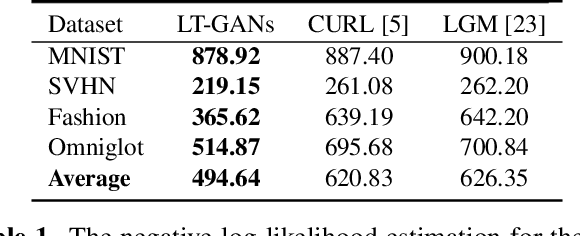
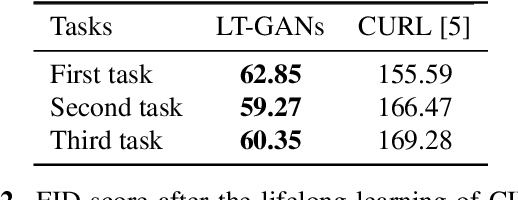
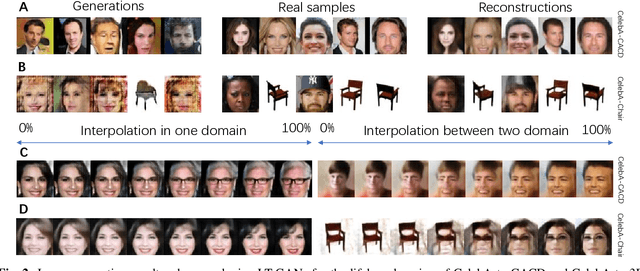
Abstract:In this paper, we propose a new continuously learning generative model, called the Lifelong Twin Generative Adversarial Networks (LT-GANs). LT-GANs learns a sequence of tasks from several databases and its architecture consists of three components: two identical generators, namely the Teacher and Assistant, and one Discriminator. In order to allow for the LT-GANs to learn new concepts without forgetting, we introduce a new lifelong training approach, namely Lifelong Adversarial Knowledge Distillation (LAKD), which encourages the Teacher and Assistant to alternately teach each other, while learning a new database. This training approach favours transferring knowledge from a more knowledgeable player to another player which knows less information about a previously given task.
 Add to Chrome
Add to Chrome Add to Firefox
Add to Firefox Add to Edge
Add to Edge